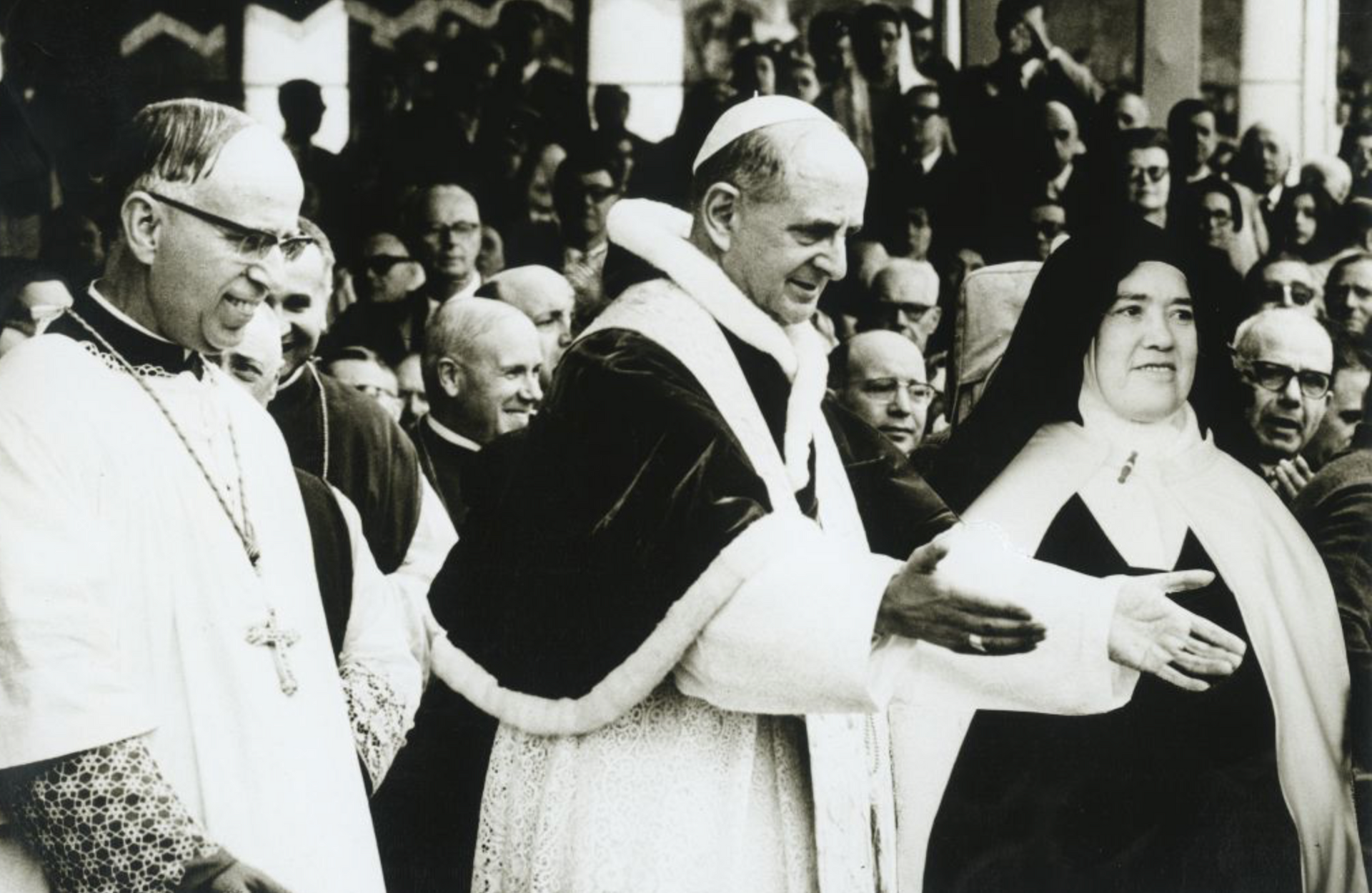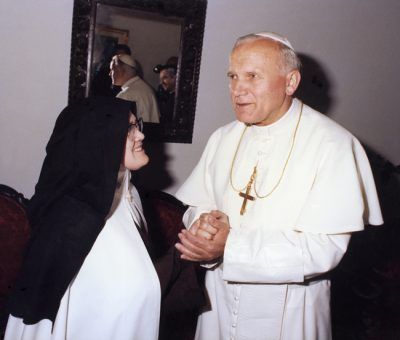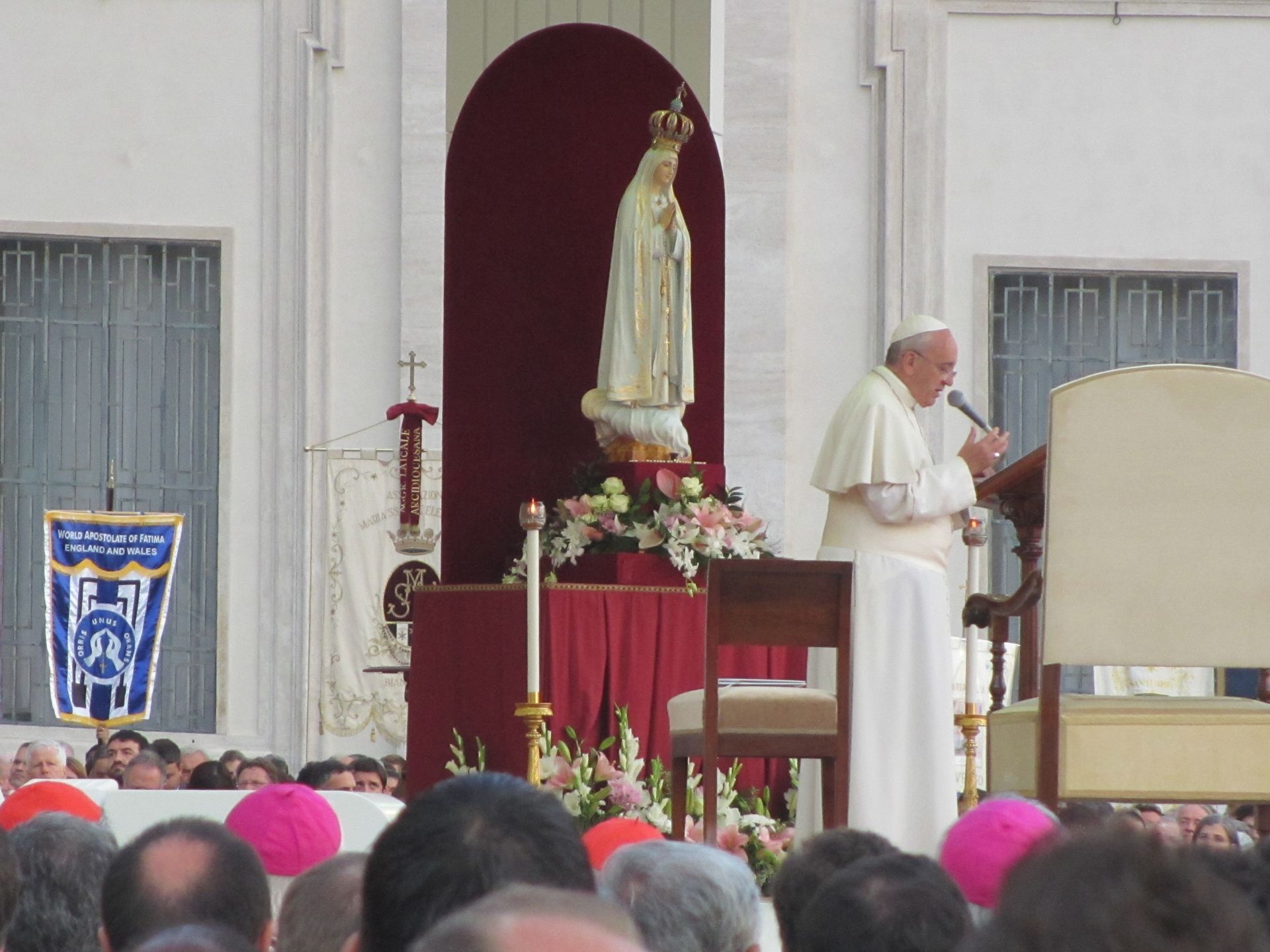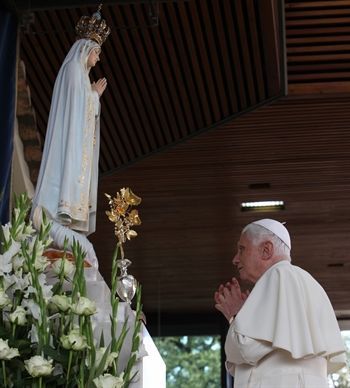The Brown Scapular
While the crowd were seeing the miracle of the sun on 13 October, the children saw various apparitions involving St Joseph and the Child Jesus, Our Lady in a blue and white mantle, and Our Lady of Dolours. These have usually been interpreted as representing the mysteries of the Rosary, but they also saw a final apparition of Our Lady of Mount Carmel.
Lucia describes how she saw this last apparition of Our Lady holding a brown scapular, so we find the brown scapular intimately associated with Fatima. She later said: “The Rosary and the Scapular are inseparable,” and “all Catholics should wear the Scapular as part of the Fátima message.”
OUR LADY AND THE BROWN SCAPULAR
The Brown Scapular is a sacramental worn around the neck. It was given to St Simon Stock, of the Carmelite Order, by Our Lady, in England, in the 13th century. She said to him:
“This will be for you and for all Carmelites the privilege, that he who dies in this will not suffer eternal fire.”
The Scapular promise is based on the two elements of Mary’s spiritual maternity and her mediation of grace, that is that she is the “spiritual” mother of all mankind, as well as the “channel” by which all grace comes to us from God.
This promise implies that Mary will intercede to ensure that the wearer of the Scapular obtains the grace of final perseverance, that is of dying in a state of grace, and this privilege has now been extended to all Catholics who are enrolled in the Scapular.
ST SIMON STOCK AND THE BROWN SCAPULAR
The Brown Scapular originated in England. In the thirteenth century, during the time of the Crusades, Simon Stock went on a pilgrimage to the Holy Land where he met a group of hermits on Mount Carmel. These claimed to be the successors of Elijah and his followers, and, Simon returned with them to England when the situation became too dangerous in Palestine because of the Saracens.
Simon was eventually elected Superior-general of the Carmelites, but he faced many problems and withdrew to his monastic room or “cell”—probably at Cambridge by this time—in order to pray to Mary; it was then that he had his famous vision of her bringing the Brown Scapular to him with the following words, which are preserved in a fourteenth century narrative: “This will be for you and for all Carmelites the privilege, that he who dies in this will not suffer eternal fire.”
THE POPES AND THE BROWN SCAPULAR
Over the centuries, the Scapular has been enriched with many indulgences and privileges by numerous popes, including Sixtus IV, Gregory X, Clement VII, Clement X, Leo XI, Leo XIII, St. Pius X, Benedict XV, Pius XI, and Pius XII. Popes Clement VII and Clement X decreed that all who wear the scapular participate in a special manner not only in the fruits of the spiritual works of the Carmelites, but also in all the good done throughout the entire Church.
By the 17th century the Brown Scapular was well known among Catholics, due in great part to the popes of the 16th and 17th centuries, who promulgated the Sabbatine Privilege and approved the Confraternity of the Scapular for all dioceses, thus allowing any Catholic to benefit from wearing the Scapular as a way of honouring Our Lady.
Pope Benedict XV (1914-22), addressing seminarians in Rome said:
“Let all of you have a common language and a common armour: The language, the sentences of the Gospel – the common armour, the Brown Scapular of the Virgin of Carmel which you ought to wear and which enjoys the singular privilege and protection after death.”
In 1951, Pope Pius XII wrote a letter to the Carmelite major superiors to celebrate the 700th anniversary of St Simon Stock’s vision, saying:
“There is no one who is not aware how greatly a love for the Blessed Virgin Mother of God contributes to the enlivening of the Catholic faith. … In the first rank of the most favoured of these devotions that of the Holy Carmelite Scapular must be placed.”
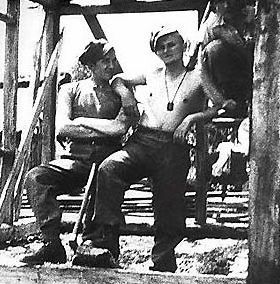
Slide title
Write your caption hereButton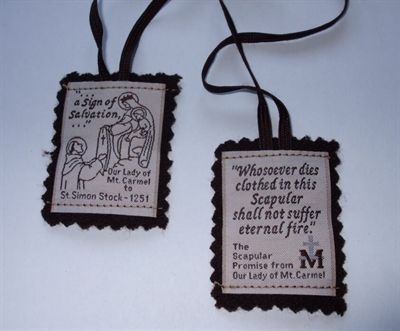
Slide title
Write your caption hereButton
POPE JOHN PAUL II & THE BROWN SCAPULAR
This picture shows Karol Wojtyla, the future Pope John Paul II as a young factory worker in Poland, wearing his brown scapular.
When he was shot and operated on in 1981, he apparently told doctors not to remove the brown scapular he was wearing, such was his devotion to it.
Speaking about the Scapular on 25 March 2001 he said:
“..the most genuine form of devotion to the Blessed Virgin, expressed by the humble sign of the Scapular, is consecration to her Immaculate Heart. …The Scapular is essentially a “habit”. Those who receive it are associated more or less closely with the Order of Carmel and dedicate themselves to the service of Our Lady for the good of the whole Church. …
“Two truths are evoked by the sign of the Scapular: on the one hand, the constant protection of the Blessed Virgin, not only on life’s journey, but also at the moment of passing into the fullness of eternal glory; on the other, the awareness that devotion to her cannot be limited to prayers and tributes in her honour on certain occasions, but must become a “habit”, that is, a permanent orientation of ones own Christian conduct, woven of prayer and interior life, through frequent reception of the sacraments and the concrete practice of the spiritual and corporal works of mercy.’
THE SABBATINE PRIVILEGE
By the mid-fourteenth century the wearing of the Scapular spread to the laity, and gradually over the centuries it has gained in popularity, particularly following the promotion of the “Sabbatine Privilege” by various Popes. This is an idea which grew out of a deepened understanding of the promise originally made to St Simon, and essentially involves the idea that Mary will intervene to help those who have worn the Scapular before death and now find themselves in purgatory, particularly on a Saturday, the day traditionally dedicated to her.
According to a Papal Bull of John XXII, Our Lady appeared to him and said of those who wear the Brown Scapular, that:
“I, the Mother of Grace, shall descend on the Saturday after their death and whomsoever I shall find in purgatory I shall free so that I may lead them to the holy mountain of life everlasting.”
Certain conditions are attached to this promise:
Firstly, that the individual should continuously wear the Brown Scapular, and that they should observe chastity according to their state in life, whether married or single.
The other condition which most usually applies today is that they should, with permission of a priest, say five decades of the rosary daily. (Previously it had been necessary to say the Little Office of Our Lady or abstain from meat on Wednesdays and Saturdays).
So all that is needed to benefit from all these privileges is to obtain a scapular, have it blessed by any priest and then get enrolled in the scapular confraternity. There are prayers for the blessing of the scapular, and for enrolment, below.
When the scapular breaks, is worn out, or is lost, you simply get a new one. You do not have to be enrolled again.
The Brown Scapular as a Sacramental
The Brown Scapular is one of the most highly indulgenced and privileged sacramentals of the Church, as well as one of the most ancient. But more than that, it is a sign of consecration to the Blessed Virgin and a powerful aid to salvation which she herself has recommended in a special way for our times.
A sacramental is, “a sacred sign which bears resemblance to the sacraments, and by means of which spiritual effects are signified and obtained through the prayers of the Church.” (CCC 1667).
In the case of the scapular, the sacred sign is the scapular itself and the spiritual effect is the protection of one’s soul through the prayers of Mary, as she promised in the vision to St Simon Stock.
Sacramentals, such as holy pictures or icons, statues, medals, holy water, blessed palms, and indeed the scapular, are means that dispose one to receive the chief effect of the sacraments themselves, which is a closer union with Jesus.
The blessing and enrolment in the scapular, to be done by a priest
Blessing of the scapular:
“O Lord Jesus Christ, Saviour of mankind; by Thy right hand sanctify this scapular (these scapulars) which Thy servant(s) will devoutly wear for the love of Thee and of Thy Mother, the Blessed Virgin Mary of Mount Carmel; so that, by her intercession, they may be protected from the wickedness of the enemy and persevere in Thy grace until death; Who livest and reignest for ever and ever.”
(The priest now sprinkles the Scapular with Holy Water.)
Enrollment:
The priest lays the Scapular over one shoulder of the person to be enrolled and says:
“Receive this blessed Scapular and ask the Most Holy Virgin that, by her merits, it may be worn with no stain of sin and may protect you from all harm and bring you into everlasting life.” (The person replies: “Amen”)
The Priest continues:
“By the power granted to me, I admit you to share in all the spiritual works performed, with the merciful help of Jesus Christ, by the Religious of Mount Carmel; in the name of the Father and of the Son, + and of the Holy Spirit. May Almighty God, Creator of heaven and earth, bless + you whom He has been pleased to receive into the Confraternity of the Blessed Virgin Mary of Mount Carmel. We beg her to crush the head of the ancient serpent in the hour of your death and, in the end to obtain for you a palm and the crown of your everlasting inheritance. Through Christ Our Lord.”
(the Person replies “Amen” – The priest now sprinkles them with Holy Water.)
FATIMA AFTER THE APPARITIONS
Meanwhile, work on the construction of the Capelinha, the Chapel of Apparitions, began on 28 April 1919 and was completed on 15 June; the first Mass was celebrated there on 13 October 1921. The pedestal on which the image of Our Lady stands in the Capelinha marks the exact spot where the little holm oak grew on which Our Lady appeared. In May 1922, Bishop Jose Correia da Silva of Leiria-Fatima, named a commission of enquiry to analyse the facts surrounding the Fatima phenomenon “with strictness and impartiality”.
On 10 December 1925, Sr Lucia, who had become a postulant with the Dorothean Sisters, was at their convent in Pontevedra, Spain, when she saw another apparition, this time of Mary with the Child Jesus. Mary told Lucia that she promised all the graces necessary for salvation to those who, on the first Saturday of five consecutive months, confessed, received Holy Communion, recited five decades of the rosary, and meditated on the rosary for fifteen minutes, all with the intention of making reparation to her Immaculate Heart.
Meanwhile, on 13 January 1924, Mass was celebrated for the first time inside the Capelinha, while on 26 June 1927, the bishop presided for the first time at an official event—the inauguration of the 14 kilometre Way of the Cross to the Cova da Iria, where he celebrated Mass in the presence of 400 pilgrims. Building work on he Basilica of Our Lady of the Rosary of Fatima was begun in 1928, and it was consecrated on 7 October 1953. It has 15 altars dedicated to the 15 mysteries of the Rosary. The bodies of Jacinta and Francisco were moved to their present positions, to the left and right of the main altar, in the early 1950s, and Sr Lucia’s body was interred in the Basilica in 2008 next to Jacinta’s. The mortal remains of Bishop Correia da Silva, who died in 1957, are interred in the Chancel.
Prior to this, on 13 June 1929 Sr. Lucia, while at prayer in the convent chapel at Tuy, saw a vision of the Most Holy Trinity, with Mary standing on the altar displaying her Immaculate Heart in her left hand. It was on this occasion that Mary asked the Pope, in union with all the bishops of the world, to make the [collegial] consecration of Russia to her Immaculate Heart that she had announced during the July 1917 apparition.
On 13 October 1930 the Bishop issued a pastoral letter on the apparitions, which, after recounting the events at Fatima, contained the following brief but important statement:
“In virtue of considerations made known, and others which for reasons of brevity we omit; humbly invoking the Divine Spirit and placing ourselves under the protection of the most Holy Virgin, and after hearing the opinions of our Rev. Advisors in this diocese, we hereby:
- Declare worthy of belief, the visions of the shepherd children in the Cova da Iria, parish ofFatima, in this diocese, from the 13th May to13th October, 1917.
- Permit officially the cult of Our Lady of Fatima.”
In thanksgiving for this development, six months later, on 13 May 1931, a vast pilgrimage of around 300,000 people came to Fatima to participate in a ceremony presided over by Cardinal Cerejeira, Patriarch of Lisbon, at which all the bishops of Portugal made the first consecration of their country. It was this consecration, and that of 1938, which preserved Portugal from the violent attack on the Church in the Spanish Civil War, and its renewal in 1940 saved Portugal from being dragged into the horrors of the Second World War.
Fatima developments from World War II onwards
On 31 October 1942, during World War II, Pope Pius XII, speaking in Portuguese by radio, consecrated the world to the Immaculate Heart of Mary, with a special mention of Russia, in response to the request he had received in a letter from Sr Lucia. Some months later Sr Lucia said that as a result of this act, God promised to end the war soon.
On 13 May 1946, Cardinal Masella, the Papal Legate, crowned the Statue of Our Lady of Fatima in the Capelinha as Queen of Peace. This crown was made from gold melted down from wedding rings donated by the women of Portugal, and it also contains over 4,000 precious stones, which they contributed in thanksgiving for Portugal having been spared the horrors of the Spanish Civil War and the Second World War.
On 13 October 1951, Cardinal Tedeschini, who was in Fatima for the closing of the Holy Year, revealed that in October 1950, at the time when he had promulgated the dogma of Mary’s Assumption into heaven, Pope Pius XII had witnessed a repetition of the solar miracle of 13 October 1917, while he was walking in the Vatican gardens.
Cardinal Roncalli, the Patriarch of Venice, and the future Pope John XXIII, presided at the ceremonies at Fatima on 13 May 1956, while, on 21 November 1964, Pope Paul VI, at the conclusion of the third session of the Second Vatican Council, proclaimed “the Most Blessed Mary Mother of the Church”; the Pope also considered it was “particularly opportune” to recall Pius XII’s consecration of the world to the Immaculate Heart of Mary; and bearing that consecration in mind, he announced before the 2,500 Council Fathers, that a Golden Rose was to be presented to the Sanctuary of Fatima (this act was carried out on 13 May 1965 by Cardinal Cento, the Papal Legate); and the Pope concluded his address by proclaiming, “to your Immaculate Heart, O Mary, we commend the entire human race”.
Pope Paul VI came to Fatima on 13 May 1967 to celebrate the 50th anniversary of Our Lady’s first Apparition, and to pray for world peace and Church unity. In a significant sign of papal approval for the message of Fatima, the Pope invited Sr Lucia to join him on the external altar in front of the crowds, and in his Apostolic Exhortation Signum Magnum, issued on the same day, Paul VI urged “all members of the Church to consecrate themselves once again to the Immaculate Heart of Mary and to translate this pious act into their daily lives”.
Ten years later, on 10 August 1977, the future Pope John Paul I, Cardinal Luciani, Patriarch of Venice, came on pilgrimage to Fatima.
UK HEADQUARTERS
World Apostolate of Fatima
Headquarters
International UK phone
Email:
Skype
PARISH ACTIVITIES


